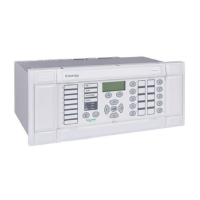P54x/EN OP/La4 Operation
(OP) 5-182
MiCOM P543, P544, P545 & P546
OP
5.6.2.1 Circuit breaker healthy (P544/P546)
The majority of circuit breakers are only capable of providing one trip-close-trip cycle.
Following this, it is necessary to re-establish sufficient energy in the circuit breaker (spring
charged, gas pressure healthy, etc.) before the circuit breaker can be reclosed.
The DDB CB Healthy input is used to ensure that there is sufficient energy available to close
and trip the circuit breaker before initiating a CB Close command. If on completion of the
dead time, the DDB CB Healthy" input is low, and remains low for a period given by the
CB Healthy Time timer, lockout will result and the circuit breaker will remain open
DDBs (436 & 437) are used for CB1 Healthy & CB2 Healthy respectively to enable
CB1 Close and CB2 Close by auto-reclose. The CB Healthy Time setting is common to
both CB1 and CB2.
This check can be disabled by not allocating an opto input for DDB CB Healthy. The signal
defaults to high if no logic is mapped to DDB within the PSL in the relay
5.6.2.2 Inhibit auto-reclose (P544/P546)
An external input ca
n be used to inhibit auto-reclose. The signal is available for mapping via
the PSL from an opto input or a communications input.
The signal is Inhibit AR, DDB (1420). This single signal applies to both CB1 and CB2.
Energising the input will cause any auto-switching to be inhibited. Any auto-reclose in
progress will be reset and inhibited, but not locked out. It is provided to ensure that auto-
switching does not interfere with any manual switching. A typical application would be on a
mesh-corner scheme where manual switching is being performed on the mesh, for which
any auto-reclose would cause interference.
If a single phase auto-reclose cycle is in progress and a single pole of the circuit breaker is
tripped when this signal is raised, a ‘force three phase trip output’, (AR Force 3 pole, DDB
(858)) will be set. This is to force the circuit breaker to trip the other phases thereby
ensuring that all poles will be in the same state (and avoiding a pole stuck condition) when
subsequent closing of the circuit breaker is attempted.
5.6.2.3 Block auto-reclose (P544/P546)
External inp
uts can be used to block auto-reclose. Two signals (one for each circuit breaker
controlled) are available for mapping via the PSL from opto inputs or communications inputs.
The two signals are:
Block CB1 AR DDB (448)
Block CB2 AR DDB (1421).
The Block CB AR input, if asserted, will block the operation of the auto-reclose cycle and, if
auto-reclose is in progress, it will force the circuit breaker to lockout.
Typically it is used where, dependent upon the type of protection operation, auto-reclose
may, or may not, be required. An example is on a transformer feeder, where auto-reclosing
may be initiated from the feeder protection but blocked from the transformer protection.
Block CB AR can also be used in cases where the auto-reclose cycle is likely to fail for
conditions associated with the protected circuit. The input can be used for example if,
anywhere during the dead time, a circuit breaker indicates that it is not capable of switching
(low gas pressure or loss of vacuum alarm occurs).

